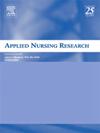大学医院急症护理部门新聘护士的培训质量:一项横断面研究。
IF 2.2
4区 医学
Q1 NURSING
引用次数: 0
摘要
目的:本研究的目的是描述如何新聘护士评估质量取向在急症护理设置在大学医院。背景:在急症护理环境中,新聘用的护士需要特殊的能力,与不同专业团体合作的能力,以及广泛的技术和技术技能,这对于确保患者安全和高质量的护理标准至关重要。方法:采用横断面研究设计。遵循加强流行病学观察性研究报告(STROBE)指南。方便样本包括来自9个手术室和4个重症监护病房的护士(N = 120)。参与者都是新入职的(一年)。数据通过在线问卷收集,包括三个部分:1)社会人口统计学和取向相关项目;2)综合导向过程评价(OPE-instrument©Peltokoski, 2016);3)采用的临床学习环境、监督和护士教师量表(CLES+ T量表©Saarikoski et al., 2008)。采用描述性和双变量统计分析。结果:有66名新入职护士参与调查;应答率为44%。综合导向过程的评估内容包括:综合导向过程的目标与责任、内容的标准化(平均3.98)、综合导向过程的实施(平均3.95)、综合导向过程的评价(平均3.31)。临床学习环境和监督质量的评估如下:病房学习场所(平均4.04)、监督关系(平均4.04)、病房氛围(平均3.77)和病房护理场所(平均3.65)。学习目标的设定和实现以及专业成长支持导向与综合导向过程、临床学习环境和监督的关系最为显著。结论:虽然新入职护士对新入职培训质量的评估处于适当的水平,但在新入职培训过程的不同检查点应进行系统的评估。应该单独设定学习目标,并监控其实现情况,以确认培训的质量。本文章由计算机程序翻译,如有差异,请以英文原文为准。
The quality of orientation for newly hired nurses in acute care settings in a university hospital: A cross-sectional study
Aims
This study aims to describe how newly hired nurses assess the quality of the orientation in acute care settings in a university hospital.
Background
Orientation for newly hired nurses in acute care settings, where special competence, ability to collaborate with different professional groups, and wide technical and technological skills are required, is crucial to ensure patient safety and high-quality standards in nursing care.
Methods
A cross-sectional study design was applied. Strengthening the Reporting of Observational studies in Epidemiology (STROBE) guidelines were followed. A convenience sample consisted of nurses (N = 120) from nine operating rooms and four intensive care units. The participants were newly hired (for one year). The data was collected via an online questionnaire including three parts: 1) socio-demographic and orientation-related items; 2) the Comprehensive Orientation Process Evaluation (OPE-instrument© Peltokoski, 2016); and 3) an adopted version of the Clinical Learning Environment, Supervision and Nurse Teacher Scale (CLES+ T Scale© Saarikoski et al., 2008). Descriptive and bivariate statistical analyses were used.
Results
66 newly hired nurses answered the survey; the response rate was 44 %. The comprehensive orientation process was assessed as follows: goals and responsibilities, and standardized content of the comprehensive orientation process (mean 3.98), implementation of the comprehensive orientation process (mean 3.95), and evaluation of the comprehensive orientation process (mean 3.31). The quality of the clinical learning environment and supervision was assessed as follows: premises of learning on the ward (mean 4.04), supervisory relationship (mean 4.04), atmosphere on the ward (mean 3.77), and premises of nursing care on the ward (mean 3.65). Setting and achieving learning goals and professional growth supporting orientation were most often statistically significantly associated with a comprehensive orientation process and a clinical learning environment and supervision.
Conclusion
Although newly hired nurses assessed the quality of the orientation at an appropriate level, evaluation should be systematically performed at different checkpoints of the orientation process. Learning goals should be set individually, and their achievement monitored to confirm the quality of the orientation.
求助全文
通过发布文献求助,成功后即可免费获取论文全文。
去求助
来源期刊

Applied Nursing Research
医学-护理
CiteScore
4.50
自引率
0.00%
发文量
65
审稿时长
70 days
期刊介绍:
Applied Nursing Research presents original, peer-reviewed research findings clearly and directly for clinical applications in all nursing specialties. Regular features include "Ask the Experts," research briefs, clinical methods, book reviews, news and announcements, and an editorial section. Applied Nursing Research covers such areas as pain management, patient education, discharge planning, nursing diagnosis, job stress in nursing, nursing influence on length of hospital stay, and nurse/physician collaboration.
 求助内容:
求助内容: 应助结果提醒方式:
应助结果提醒方式:


